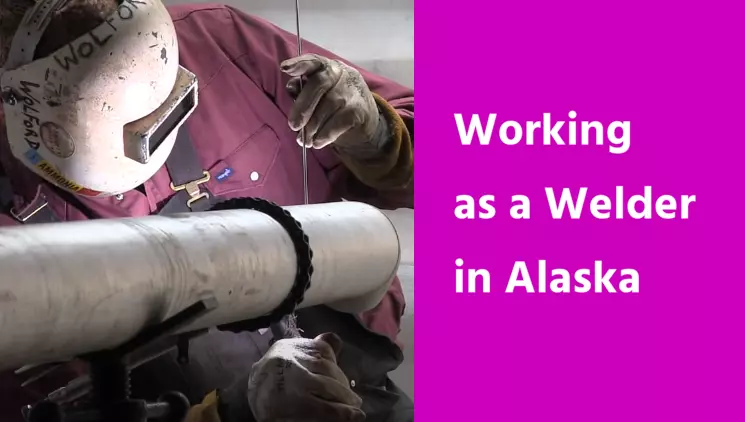Welders in Alaska have a crucial role in the state’s economy, as many industries require their expertise.
These professionals work on various projects, from repairing pipelines to maintaining power plants and even building planes. They use their skills and knowledge in metallurgy and welding techniques to modify, shape, and fuse metal objects.
Welders must follow detailed specifications to complete their tasks, ensuring that the project’s structural integrity is maintained.
Additionally, they need to inspect their work carefully, looking for imperfections and defects that could affect the structure’s safety. Welders must also be mindful of workplace safety practices, including wearing appropriate protective gear.
One of the most critical tasks for welders in Alaska is maintaining the Trans-Alaska Pipeline system, which requires regular maintenance and repairs due to its age. Welders must also service the state’s vast aviation system, which requires aircraft maintenance and repair, including welding.
Additionally, Alaska’s coastline has several shipyards where welders are needed to repair and maintain various vessels, including fishing boats, yachts, and cruise ships.
Welders must also cope with the various power plants in Alaska, where they are required to repair and replace corroded pipes or provide welding services to boilers and other equipment that is prone to damage.
Given the state’s growing economy, the outlook for welders in Alaska is positive, with an expected 14% job growth by 2030. Charter College offers a welding program that can prepare students for entry-level positions in the field, providing them with the skills and knowledge necessary to succeed in a welding career.
Welders in Alaska are expected to have a steady workload, and with the right education and training, they can build a long and fulfilling career.
Qualifications and certificates
There is a lot of work in Alaska, so new people, specialists and professionals are always needed.
And, of course, Alaska requires certified welders. The University of Alaska Anchorage (UAA) offers an Occupational Endorsement Certificate (OEC) in welding that will help you succeed in the welding industry.
This welding program provides students with hands-on experience with modern welding booths, oxy-acetylene and plasma cutting equipment, industrial band saws, and metal shears. Welders with a degree from UAA can find entry-level positions in a variety of industries, including the military.
The OEC welding program necessitates 19 credits, and the UAA welding facility is recognized by the American Welding Society (AWS). Welders can take a test and get certified for work on state infrastructure projects through this program. The instructors in UAA’s welding program are all Certified Welding Inspectors (CWIs), so students may learn a wide range of skills that are relevant to the welding industry.
UAF also provides a foundational vocational endorsement program in welding that sets students up for success in the workplace. Students aged 16 and above are welcome to enroll in the American Welding Society’s School Excelling through National Skill Standards Education (AWS SENSE) training program. Graduates with credentials in four welding processes and the AWS SENSE Entry-Level I will stand out to potential employers.
Wages for Welders in Alaska
| Position | Grade | Salary per year |
|---|---|---|
| Entry-level welder | Grade 1 | $40,000 – $50,000 |
| Welder I | Grade 2 | $50,000 – $60,000 |
| Welder II | Grade 3 | $60,000 – $70,000 |
| Senior Welder | Grade 4 | $70,000 – $80,000 |
Welders play an important role in construction, maintenance, and repair projects that require welding techniques to join, fabricate or repair metal and other materials. In Alaska, the average salary for a Welder I is $49,767, according to data from Salary.com as of May 25, 2023. The salary range varies depending on various factors such as education, certifications, additional skills, and the number of years of experience in the profession. In general, the range typically falls between $44,281 and $57,007.
The department or company location is also a significant factor that affects the salary range. In general, the salary range in metropolitan areas and cities may be higher than in rural areas. The salary range for Welder jobs in Alaska can vary widely, and it has been reported that some welders in Alaska make up to $68,500 per year. However, the salary can also vary between $28,000 to $118,000, depending on skills, experience, and employer bonuses and tips.
It is worth noting that the average income reported to the IRS in box 1 of W-2 may include wages, tips, bonuses, and other forms of compensation. The reported salaries here are not representative of the entire population, and the total salary ranges shown here exclude outliers. As a result, the information obtained from these sources provides a snapshot of the welding profession in Alaska. Overall, a career as a welder in Alaska can be rewarding, and salary figures can vary greatly depending on a wide range of variables.

FAQ
Q: What are the benefits of working as a welder in Alaska?
A: There are several benefits of working as a welder in Alaska, including high demand for welders, the opportunity to work in various industries, and competitive salaries.
Q: Why is there a high demand for welders in Alaska?
A: Alaska has a significant need for welders due to its extensive aviation system, shipyards, power plants, and the Trans-Alaska Pipeline. Welders are valuable for maintenance and repair of critical infrastructure in these industries.
Q: What is the Trans-Alaska Pipeline, and why does it require maintenance from welders?
A: The Trans-Alaska Pipeline is one of the largest pipeline systems in the world, connecting oil fields in Prudhoe Bay to Valdez Harbor. The pipeline’s aging infrastructure requires regular maintenance and repair, and welders play a vital role in repairing any cracks or leaks that occur.
Q: What kind of opportunities are there for welders in Alaska’s aviation industry?
A: Alaska boasts the largest aviation system in North America, with many cities having their own airfields. Aerospace welders are vital in repairing and maintaining airplanes, jets, and helicopters used for transportation in the state.
Q: What industries utilize shipyards in Alaska, and how do welders contribute to these industries?
A: Alaska’s coastline has several major shipyards that provide repair and maintenance services to many industries, including fishing, yachting, and cruise ships. Welders are an essential part of this process, fusing metal parts together, building new components, and completing welding repairs.
Q: What role do welders play in Alaska’s power plant industries?
A: Power plants require maintenance and frequent repairs, including repairs to extensive piping and boilers that can wear out over time. Welders are valuable in replacing corroded pipes, welding small components, and protecting equipment from further erosion.
Q: What is the outlook for welders in Alaska, and how does it compare to other states?
A: The Alaska Department of Labor and Workforce Development projects an almost 14% job growth for welders by 2030. Additionally, Alaska is a high-paying state for this profession, making it a desirable location for welders looking to start or advance their careers.







